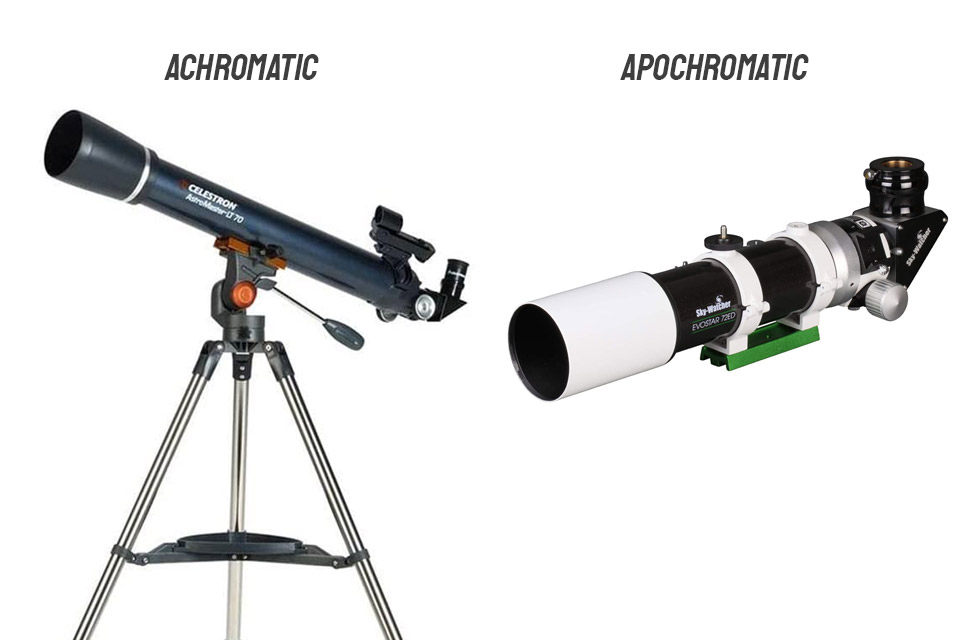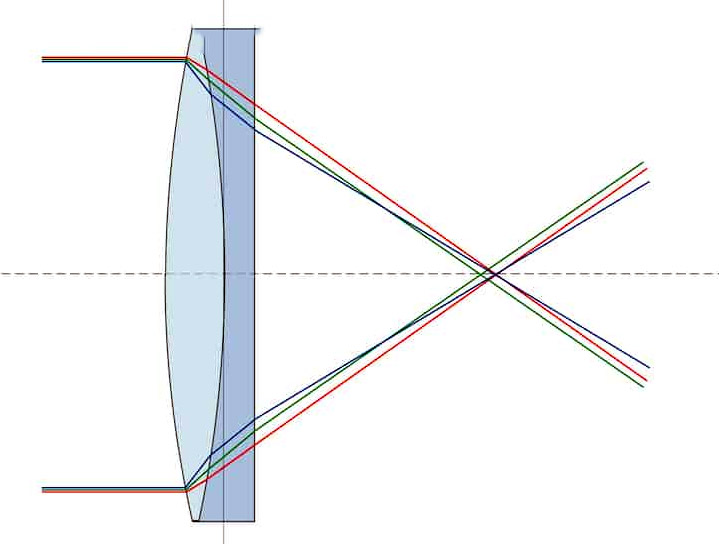You see two telescopes. Both are refractors. Both have the same aperture and similar specs. Both are from the same brand. But one of them costs five times more than the other and it even includes fewer accessories than the cheaper one.
What is going on?
Chances are, you just ran into an achromatic and an apochromatic refractor. On paper, they seem very similar. If you look at them as a beginner neither looks too different from the other, but they are.
And that’s sometimes the problem when researching telescopes. Most of the things that make a difference are imperceptible and have more to do with the design of the lenses or mirrors.
But don’t worry, in this article I’ll explain all the differences and similarities between achromatic and apochromatic telescopes.
Let’s get to it.
Note: I’ll sometimes refer to apochromatics as APOs as they are also commonly known.
Achromatic vs Apochromatic similarities

- Both are in essence refracting telescopes. This means the primary lens refracts (bends) the light it captures to target it into a single point where at the end of the tube. The diagram below shows how this works.
- Both use lenses instead of mirrors like other telescope types. This is because they are generally smaller (lenses are too hard to manufacture in large sizes).
- Both have the focuser at the end of the tube.
- The focal length of both is almost equal to the length of the tube because the light follows a straight path inside.

In general, all the similarities between achromatic and apochromatic telescopes have to do with the fact they are both refracting telescopes. If you want to learn more about refractors check out this article on the pros and cons of refracting telescopes where these points are discussed in detail.
Achromatic vs Apochromatic differences
The main difference between achromatic and apochromatic refractors is the complexity of the primary lens. Achromatics use a doublet (2-element) lens while APOs use a triplet (3-element lens).
The design of the 2-element lenses used in achromatic telescopes dates back all the way to 1700s. It is very simple and also relatively inexpensive which is what makes refractors the most popular telescope design for beginners (see our guide on the best refractors for beginners for more on this.). The lens bends the light and focuses it into a single point, however, because it bends each wavelength slightly different, some wavelengths don’t end up pointing at the same spot. This causes them to “miss” some colors and it is what creates “chromatic aberrations” which sounds like an ugly disease but it just means the resolved image in the telescope might have small color errors or colored halos around certain objects. The magnitude of these errors depends a lot on the quality of the lens.
On the other hand, the 3-element design of apochromatic lenses refracts all the light’s wavelengths with more precision and focuses it all into a single point. This almost completely eliminates chromatic aberrations and also results in an image with a slightly higher color gamma.
As you might expect, this also means apochromatic lenses are considerably more expensive. So much so that APOs are generally targeted at more advanced astronomers and stargazers.
APOs are also ideal for astrophotography because they are very “fast” thanks to their short focal length.
But is the difference big enough to justify such an increase in price?
Well, here’s a comparison. The first photo was taken using a basic 70mm achromatic refractor. The second was taken with an 80mm apochromatic. Don’t look too much into the quality of the image as they were taken using completely different cameras and the APO has a larger aperture so that comparison would be unfair. What I want you to take a look at is the blue halo at the top of the Moon in the first photo and how the color gamma is much more limited. That is a very obvious case of chromatic aberration.


The effect can be a little more obvious on deep space objects where the color clearly bleeds around the stars.


Since APOs are usually marketed to more advanced enthusiasts, they often include other premium features such as better focusers, full metal bodies, and more refined manufacturing processes for the lenses. I wouldn’t consider those really a difference between the two types of refractors because those features could be added to premium achromatics if manufacturers wanted to build them.
What does ED mean? is it the same as an APO?
One term that is worth mentioning while we are talking about achromatics and APOs that created confusion is ED. Some people refer to ED as if it was some type of telescope or as if it had something to do with apochromatic refractors. So let’s clear that up.
ED is short for “Extra-Low Dispersion”. It is a very premium type of glass used in telescope lenses that prevents the dispersion of color, resulting in better color correction.
It has nothing to do specifically with apochromatic telescopes, but because it is an expensive manufacturing technique, it is only used in higher-end APOs.
Because other types of telescopes use mirrors instead of lenses, the technique is almost exclusively used in APOs.
Summary
- Achromatic and Apochromatic are both types of refracting telescopes
- The main difference between them is the design of the primary lens (usually 2-elements vs 3-elements)
- This difference fixes most optic errors found in traditional achromatic telescopes that are usually made for entry-level hobbyists







